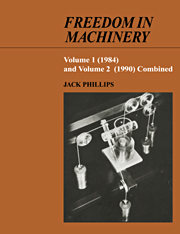Book contents
- Frontmatter
- Dedication
- Contents
- Preface
- General introduction
- 1 Mechanism and the mobility of mechanism
- 2 Overconstraint and the nature of mechanical motion
- 3 Some of the various lines in a moving body
- 4 Enumerative geometry and the powers of infinity
- 5 Rigidity and the instantaneous screw axis
- 6 Irregularity and the freedoms within a joint
- 7 The possibilities in reality for practical joints
- 8 Some elementary aspects of two degrees of freedom
- 9 The linear complex of right lines in a moving body
- 10 Line systems and the dual vectors in mechanics
- 11 Geometrical properties of the linear line systems
- 12 The vector polygons for spatial mechanism
- 13 On the two theorems of three axes
- 14 Some reciprocities across the middle number three
- 15 The generality and the geometry of the cylindroid
- 16 The discovery in a mechanism of a cylindroid
- 17 Action, notion, clearances and backlash
- 18 Singular events in the cycles of motion
- 19 Fundamental relations and some algebraic methods
- 20 The special geometry of some overconstrained loops
- 21 The helitangent lines in a moving body
- 22 The cylindroid in gear technology
- 23 The general and the special screw systems
- Bibliography
- Index of proper names
- Subject Index
0 - General introduction
Published online by Cambridge University Press: 07 September 2010
- Frontmatter
- Dedication
- Contents
- Preface
- General introduction
- 1 Mechanism and the mobility of mechanism
- 2 Overconstraint and the nature of mechanical motion
- 3 Some of the various lines in a moving body
- 4 Enumerative geometry and the powers of infinity
- 5 Rigidity and the instantaneous screw axis
- 6 Irregularity and the freedoms within a joint
- 7 The possibilities in reality for practical joints
- 8 Some elementary aspects of two degrees of freedom
- 9 The linear complex of right lines in a moving body
- 10 Line systems and the dual vectors in mechanics
- 11 Geometrical properties of the linear line systems
- 12 The vector polygons for spatial mechanism
- 13 On the two theorems of three axes
- 14 Some reciprocities across the middle number three
- 15 The generality and the geometry of the cylindroid
- 16 The discovery in a mechanism of a cylindroid
- 17 Action, notion, clearances and backlash
- 18 Singular events in the cycles of motion
- 19 Fundamental relations and some algebraic methods
- 20 The special geometry of some overconstrained loops
- 21 The helitangent lines in a moving body
- 22 The cylindroid in gear technology
- 23 The general and the special screw systems
- Bibliography
- Index of proper names
- Subject Index
Summary
Some observations
01. This book deals with mechanism. Mechanism is presented here as the geometric essence of machinery. The study of mechanism is important because the geometry of mechanical motion is often the crux of a real machine's design. The kind of motion I call mechanical motion is that which occurs between the rigid, contacting bodies or the material links of mechanism. This occurs in conjunction with two phenomena that happen together at the places of contact between the bodies. Firstly, transmission and other forces operate between the bodies as the motion occurs; and secondly, the shapes of the surfaces there guide the bodies as they move. A contact is a constraint upon a body's motion. Each movable body in machinery suffers its constraints accordingly. If we wish to penetrate the deeper issues at work in real machinery, if we wish to control (or at least not to be bamboozled by) the overwhelming complexity of the constraints upon the mechanical movements occurring constantly within machinery and thereby all about us, we must grapple with these constraints as directly as we can.
02. The digital computer demands on the part of its machine-designing users a ruthless competence in the algebraic processes needed for the manipulation of mechanical information and its numerical analysis. It is accordingly fashionable just now in the field of the theory of machines not so much to denigrate as simply to ignore the main bases in actual mechanical motion from which these algebraic processes grow. The main bases are essentially pictorial, geometrical. They arise from natural philosophy.
- Type
- Chapter
- Information
- Freedom in Machinery , pp. 1 - 5Publisher: Cambridge University PressPrint publication year: 2007

